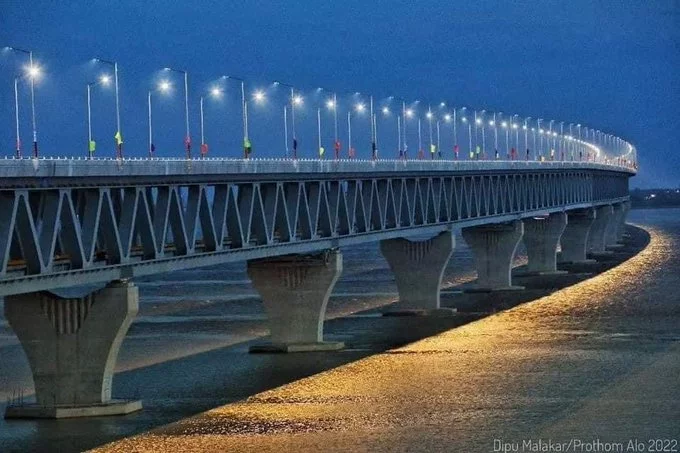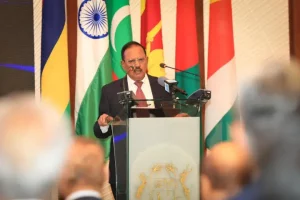Earlier this month, Bangladesh Railway ran the first train on the newly finished rail line connecting Bhanga to Mawa through the Padma Multipurpose Bridge. The Bhanga-Mawa rail line is only one part of a much larger rail line, that when finished, will connect Dhaka to Jessore.
#Bangladesh Railway ran the first train on the newly constructed Bhanga-Mawa #rail line through the #PadmaBridge on Tuesday 4th April. It is critical progress to the Padma Bridge Rail Link project.The project is 75% completed.
👉https://t.co/bv9bokrFQX#AwamiLeauge #Connectivity pic.twitter.com/Ph1BEvi3zv— Istiak Ahmmad (@istiak_ahmmad) April 5, 2023
The planned route length of the entire line is around 169 km, and is divided into 4 parts- from Dhaka to Gandaria, Gandaria to Mawa, Mawa to Bhanga and finally, Bhanga to Jessore. Known as the Padma Rail Link Project, this rail line is expected to become the 4th trans-Asian railway route in Bangladesh, connecting India through the Petrapole border and joining the districts of Beanpole, Jessore, Narail, Bhanga and Mawa to Gundam border in Myanmar, via Narayanganj, Dhaka, Tongi, Akhaura, Chittagong and Dohazari. It is a project for acceleration of regional connectivity, that is expected to reap rich dividends for Bangladesh and expand intra-regional trade.
In over the decade that Sheikh Hasina has been in power, she has shown herself to have an astute understanding of how to achieve meaningful and long-lasting progress in societies with deep economic divisions. She and her government have managed to devise a plan to bring about development that is not concentrated in one area, but rather, is expanded outwards to the margins, in order to bring them into and make them an integral part of the network of mainstream economic development. The Padma Multipurpose project and the rail line is a part of her integrative development approach that will connect bustling commercial capital Dhaka to the economically backward South-west part of the country through a much shorter route. In fact this route will be 212 km shorter than the existing route of the Dhaka-Jessore-Khulna railway line. The completed rail line is expected to reap rich dividends for the areas it will connect.
Construction of the Padma bridge, also known as a road-rail bridge was completed last year. It is the longest bridge, not only in Bangladesh, but also over the river Ganga, of which Padma is a distributary in Bangladesh. The construction of this massive bridge was a huge undertaking, not only because of its location above fierce Padma, but also because it is a two-tier multipurpose bridge. While the top deck contains four roadway lanes, the bottom deck consists of a broad-gauge single railway track.
Before this bridge, the South-western districts of Munshiganj, Shariatpur, Madaripur and Narail had low accessibility and were completely detached from the Dhaka-Chittagong economic corridor.
📷 People on motorcycles gather at the toll plaza of Padma Bridge as they leave Dhaka to celebrate Eid al-Fitr at home with family, in Munshiganj, Bangladesh.https://t.co/ImGYE2Rv9x pic.twitter.com/jT0XtUZhl7
— Voice of America (@VOANews) April 20, 2023
The only means of transport and communication to the south western districts was through the waterways- ferries and boats, which was arduous, unreliable and time consuming. This is one of the main reasons for this region not having seen much industrialisation, resulting in poor economic conditions and rampant unemployment. The hope is, with the Bridge and the rail services improving accessibility and connectivity to the economic center of Dhaka, the area will attract investments, resulting in employment opportunities for people and improved living conditions. There is potential for several large and small scale industries to develop in the region such as ready made garments, food processing, agricultural products and jute. Fish trade would also become easier and much more profitable when the entire road and rail link project is completed. Tourism could also receive a boost with more people being able to travel to the south-west from Dhaka easily and in a very short time, which would most likely lead to the cropping up of many small and big economic enterprises creating further employment opportunities for the people of the region.
The bridge has also resulted in the relaxation of traffic at the waterway terminals in Dhaka which are generally inundated with people travelling to their home districts during the festive season. Once the construction of all four parts of the rail line is complete, there are plans to further extend it to the Mongla port and perhaps even the Payra Seaport being developed in the southern district of Patuakhali, which will boost trade and investment even more, benefitting the entire south-western region. Additionally, the Padma bridge has led to the relaxation of traffic at waterway terminals.
Adding to the growth of India’s Northeast.
Signing of Standard Operating Procedures for the use of Chattogram and Mongla ports of Bangladesh will enable easier transportation of goods to and from our Northeast.
Fascinating products from the Northeast will get better markets! pic.twitter.com/FICrYLLYWF
— Narendra Modi (@narendramodi) October 5, 2019
It won’t be wrong therefore, to suggest that the Padma Rail Link Project has the potential to completely transform the south-western region and indeed the entire Bangladesh. It is the next stage in Sheikh Hasina’s ambitious plan to speed up Bangladesh’s development by 2026. The biggest strength of her strategy for development has been to look to the people of Bangladesh as active collaborators and stakeholders in the growth process.
Hasina’s vision of development is not narrow and exclusivist. Rather, her government has understood that long lasting development takes time to become a reality. Therefore, plans and execution need careful coordination. Bangladesh has set a bold precedent for less developed countries to choose their path, on their own terms to achieve lasting success.
Also Read: Sheikh Hasina’s Bangladesh looks ahead, begins free trade negotiations with 11 countries




















